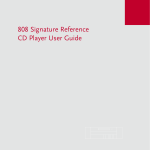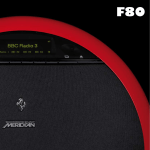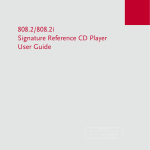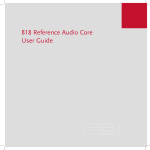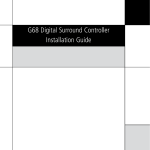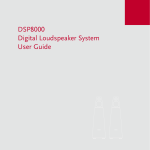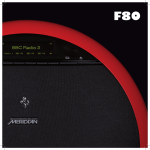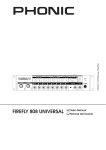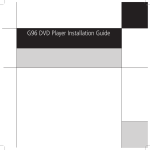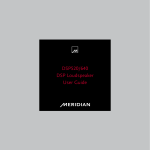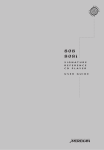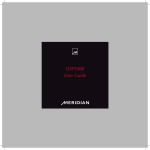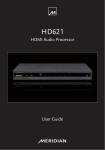Download Meridian 808.3 User guide
Transcript
808.3 Signature Reference CD Player User Guide ii Preface Important safety instructions • • • • • • Read the instructions. Keep these instructions. Follow all instructions. Do not use this apparatus near water. Clean only with a dry cloth. Install only in accordance with the manufacturer’s instructions. • Refer all servicing to approved service personnel. WARNING: TO REDUCE THE RISK OF FIRE OR ELECTRIC SHOCK, DO NOT EXPOSE THIS APPARATUS TO RAIN OR MOISTURE. To avoid overheating • Leave at least 10cm around the equipment to ensure sufficient ventilation. Do not position the unit: • In direct sunlight. • Near heat sources, such as a radiator. • Directly on top of heat producing equipment, such as a power amplifier. To avoid interference This apparatus has been designed with Class 1 construction and must be connected to a mains socket outlet with a protective earthing connection (the third grounding pin). Do not position the unit: This apparatus uses a single-pole power switch. As a result it is not isolated from AC mains power when switched off at the rear panel. The apparatus may be isolated from mains power either by unplugging the power connector from the rear of the unit, or by unplugging the connector at the opposing end of the power cord or cable from its supply outlet. As a result, either or both of these connectors should remain accessible Radio interference Safety warnings • Do not expose the unit to dripping or splashing. • Do not place any object filled with liquid, such as a vase, on the unit. • Do not place naked flame sources, such as lighted candles, on the unit. • Near strong electrical or magnetic radiation, such as near a power amplifier. FCC Warning: This equipment generates and can radiate radio frequency energy and if not installed and used correctly in accordance with our instructions may cause interference to radio communications or radio and television reception. It has been type-tested and complies with the limits set out in Subpart J, Part 15 of FCC rules for a Class B computing device. These limits are intended to provide reasonable protection against such interference in home installations. EEC: This product has been designed and type-tested to comply with the limits set out in EN55013 and EN55020. iii Contents Contents Introduction 1 The 808.3 Signature Reference CD Player 2 Specifications 3 Using the 808.3 Signature Reference CD Player 5 Front panel keys 6 MSR+ keys 7 Switching on and off 8 Playing a disc 9 Stopping and pausing play 10 Repeat 11 Scanning a disc 12 Programming a selection 13 Changing the absolute phase 14 Changing the front-panel display 15 Using the preamplifier features 17 Selecting a source 18 Adjusting the system volume 19 Changing the balance 20 Installing the 808.3 Signature Reference CD Player 21 Unpacking 22 Applications 24 Configuring the 808.3 Signature Reference CD Player 31 Choosing a standard setting 32 Setting up sources 33 Index 35 iv Preface Copyright and acknowledgements Sales and service in the UK Meridian Audio Ltd Latham Road Huntingdon Cambridgeshire PE29 6YE England Tel (01480) 445678 Fax (01480) 445686 Sales and service in the USA Meridian America Inc 8055 Troon Circle Suite C Austell GA30168-7849 USA Tel (404) 344 7111 Fax (404) 346 7111 http://www.meridian-audio.com Designed and manufactured in the UK Meridian Audio Ltd Latham Road Huntingdon Cambridgeshire PE29 6YE England Copyright © 1999-2010 Meridian Audio Ltd. Visit us on the Web: http://www.meridian-audio.com Part no: 808U/3 (P85624) MHR: this product incorporates copyright protection technology covered by certain patent applications and intellectual property of Meridian Audio Ltd. This technology is provided for the express purpose of securely containing copyright audio within the Meridian System only. Reverse engineering or circumvention of this protection is strictly prohibited. Boothroyd|Stuart Meridian, Meridian, and Sooloos are registered trademarks of Meridian Audio Ltd. This guide was produced by: Human-Computer Interface Ltd, http://www.interface.co.uk Introduction Introduction Welcome to the Meridian 808.3 Signature Reference CD Player. This User Guide provides full information about using the 808.3 in conjunction with your other equipment, to achieve the superb results you can expect from it. Introduction The 808.3 Signature Reference CD Player The 808.3 Signature Reference CD Player takes Compact Disc playback to an entirely new level, with a heritage that includes the multiple award winning 508 and 800, and two dozen optical disc players from 1984 to the present day. The 808.3 is specifically designed as a CD-optimised machine, able to play audio CDs, CD-Rs, and CD-R/Ws. It also plays the CD layer of an SACD disc. At the heart of the 808.3 are fully-integrated electronics and a computer-style CD-ROM drive. The drive normally operates at standard CD speed, but is capable of much faster reading, using multiple high-speed re‑reads to ensure accurate recovery of data from even the most difficult disc. This capability alone provides over ten times the error correction of a conventional CD player. Signal Processing Once the digital data stream has been recovered from the disc, powerful on-board digital signal processing (DSP) with a capability of an impressive 150 MIPs upsamples the digital information from the 16-bit 44.1kHz signal of conventional CD to a 24-bit signal with a sample rate of 176.4kHz. This signal is fed to the high-quality DACs to drive the analogue outputs, while a digital signal at an 88.2kHz sample rate is supplied to the digital outputs. Upsampling is performed with very high-accuracy filters which minimise pre-echo arising from ADCs and DACs used in the recording and replay process so that the total chain closely represents transmission of sound through air, for ultimate transparency from all sources. The 808.3 employs a triple buffering system to minimise jitter, and therefore maximise HF transparency and stereo image precision and stability. This, and the digital electronics as a whole, are driven by a new design of high-stability clocking system which further reduces jitter and ensure that the highest level of detail is recovered from a disc. All digital data is accurately re-clocked. Multiple power supplies ensure that digital and analogue circuitry are kept apart and can provide the required power when called upon to do so. Integrated preamplifier The 808.3 Signature Reference CD Player includes a built-in stereo preamplifier with the ability to handle six stereo analogue inputs, three digital coaxial S/PDIF inputs, and two Toslink optical digital inputs, making it ideal as the heart of a superb stereo music system. It also includes a Sooloos network connection System integration The 808.3 Signature Reference CD Player provides balanced and unbalanced analogue outputs for connecting to an external power amplifier or preamplifier. Alternatively, it provides SpeakerLink and coax digital outputs, allowing it to drive Meridian DSP Loudspeakers directly. The digital outputs support MHR (Meridian High Resolution) and operate at up to 2 x CD sample rate (88.2kHz), 24-bit. Meridian Comms sockets (2 x DIN) allow communication with other Meridian components, while an RS232 interface provides full remote control capability as well as the ability to configure the unit with Meridian’s innovative Windows-based graphic configuration application. Three programmable trigger outputs are provided for direct control of external devices, for example powering-up amplifiers, etc. The Meridian 808.3 Signature Reference CD Player is supplied with the MSR+ learning/programmable remote control, which not only operates all Meridian products but also includes an extensive database of third-party products and the capability to learn commands from existing remotes. Introduction Specifications Drive Controls • Internal CD-ROM drive. Front-panel facia controls for: Audio outputs • Open/Close, Play, Stop, Pause, Previous, Next, and On/Off. • • • • • 2-channel balanced audio output. 2-channel unbalanced audio output. 2-channel digital coax output. Two 2-channel Meridian SpeakerLink outputs. Optional MHR encryption on digital outputs at high rate Audio inputs • Six 2-channel unbalanced analogue inputs. Adjustable sensitivity. Renameable legends. • Three 2-channel digital coax inputs. Renameable legends. 44.1kHz to 96kHz sampling and up to 24bit precision. • One 2-channel Meridian SpeakerLink input. Renameable legends. 44.1kHz to 96kHz sampling and up to 24-bit precision. • Two 2-channel digital optical inputs. Renameable legends. 44.1kHz to 96kHz sampling and up to 24bit precision. Signal processing The 808.3 uses Meridian’s proprietary DSP software to provide the following powerful features: • • • • Apodising filter. Upsampling. FIFO and error correction. Resolution enhancement. A hinged control panel provides additional controls for: • Repeat, Fast Forward/Reverse, Source, Store, Clear, Display, Mute, and Volume +/-. Display • 20-character dot-matrix display with adjustable brightness and contrast. • Indicators for Emphasis, Repeat, and Phase. Introduction Using the 808.3 Signature Reference CD Player Using the 808.3 Signature Reference CD Player This chapter provides a summary of the functions of the 808.3 Signature Reference CD Player to identify the controls which you use to operate the unit. It also provides step-by-step instructions for operating the 808.3, using either the front panel or the MSR+. Using the 808.3 Signature Reference CD Player Front panel keys Phase– Indicates inverted phase Eq Emphasis indicator Fast Reverse Scans backwards Repeat Repeats a track/disc Repeat Repeat indicator Clear Clears a track selection Fast Forward Scans forwards Source Selects a source Mute Mutes or restores the sound Display Changes the information displayed Store Stores a track selection Eq Repeat Phase- Repeat Store Source Clear Display Volume Mute Signature Reference CD Player 808.3 Volume Off Drive CD drive Play Plays the disc Open Opens/closes the disc drawer Pause Pauses the disc Stop Stops the disc Off Switches to standby Next/Previous Selects the next or previous track Volume keys Change the system volume Using the 808.3 Signature Reference CD Player MSR+ keys Previous Selects the previous track Source keys Select a source Fast reverse Scans backwards CD RADIO DVD AUX DISC TAPE Stop Stops the disc Open Opens the disc tray TV OFF Switches to standby Play Plays the disc CABLE SAT Next Selects the next track VCR1 VCR2 GAME OFF Pause Pauses the disc Power 1 1 4 7 2 3 Page 5 8 6 9 0 Return Menu Repeat Slow Subtitle Band Angle Clear Display Mute OSD Repeat Repeats a track/disc A-B Repeats a section Menu keys Select or change the balance, phase, contrast, or brightness Volume keys Change the volume DSP Phase Store Record Number keys Select a track by number Function Selects a special function Open A-B Top Menu # Page Enter Setup Function Audio Fast forward Scans forwards Clear Clears a selection Store Stores a selection Mute Mutes or restores the sound Display Changes the front-panel display Using the 808.3 Signature Reference CD Player Switching on and off When not playing, the 808.3 should be left in the standby state. This uses a minimal amount of electricity, but ensures that the components of the 808.3 operate at maximum efficiency from the moment you start. If you are not going to use the 808.3 for several days you should switch the unit off completely at the rear panel, and disconnect it from the AC power supply. To switch on from standby • Press å, *, or > (front panel), or select a source. If the 808.3 is part of a Meridian system it will automatically switch on any other units in the system, such as the 861 Reference Digital Surround Controller and Meridian DSP Loudspeakers. To insert a disc • Press å (front panel) or Function * (remote) to open the tray. • Place your disc in the tray, label side up. • Press å (front panel), Function * (remote), or > to close the tray. To switch to standby • Press Off (front panel or remote). If you have other Meridian equipment or Meridian DSP Loudspeakers connected to the 808.3 these units will also switch to standby. If a disc is currently playing, switching to standby will stop the disc, and the disc can safely be left in the unit. Always remove any disc before moving or shipping the 808.3. Using the 808.3 Signature Reference CD Player Playing a disc The compact disc player allows you to play an entire disc, or start playing from any track. While a disc is playing you can go back to the start of the track or skip to the start of the next track. If you have programmed a selection, these functions also work with the selection of tracks you have programmed. For information about programming see Programming a selection, page 13. To play the disc • Press > (front panel or remote). The display will show your selection. Play l The display will then show the track number and elapsed time. For example: 1 To restart the current track • Press [ (front panel or remote). To move to the next track • Press > (front panel or remote). • Press ] or [ (front panel or remote) to step through the track numbers until the track you want to play is displayed, or type the number of the track (remote only). For example: Track 4 After a short delay the track you have selected will start to play. If you have other Meridian sources you should ensure that the 808.3 is the currently selected source. For example: To play starting from a particular track 00:12 10 Using the 808.3 Signature Reference CD Player Stopping and pausing play To stop playback • Press * (front panel or remote). The display will show the total number of tracks on the disc. For example: 16 --:-- To pause playback You can pause a disc while keeping it spinning, so that you can resume play instantly. • Press = (front panel or remote). You can change tracks while the disc is paused using [ or ] (front panel or remote). To continue after pausing • Press = or > (front panel or remote). 11 Using the 808.3 Signature Reference CD Player Repeat You can choose to play a track, disc, or selection repeatedly, so that when it has played it will start again from the beginning. To continuously repeat a disc • Press Repeat (remote or under the front panel) to select between the following options: Display Description Repeat track Repeat current track. Repeat disc Repeat entire disc. To repeat between two positions • Press A-B (Function Repeat on the remote) at the start of the section you want to repeat. The display shows: Repeat A- • Move to the end of the section you want to repeat. • Press A-B (Function Repeat on the remote) again. The display shows: Repeat A-B The section you have specified will be played repeatedly. To cancel A-B repeat • Press A-B. To cancel the repeat function • Press Repeat (remote or under the front panel) again. 12 Using the 808.3 Signature Reference CD Player Scanning a disc The scan controls allow you to move quickly to any position on the disc at either twice or eight times normal speed. To scan through a disc • Press ˘ or ¯ (remote or under the front panel) to select twice normal speed. • Press ˘ or ¯ again to select eight times normal speed. The display will show you the position on the disc. For example: 3 12:37 • Press > (front panel or remote) when you have reached the position you want to play. Alternatively press ˘ or ¯ again from eight times normal speed to return to normal playback. 13 Using the 808.3 Signature Reference CD Player Programming a selection You can programme a selection of tracks and then play only the tracks you have programmed. To make a selection by omitting tracks You can programme a selection either by storing the tracks you want to play, or by clearing the tracks you do not want to play. If you programme a selection by storing the tracks you want to hear, you can play the tracks in any order and repeat tracks in the sequence. The display will show the track number. You can programme a selection while the disc is playing, in which case the selection will be played after the current track finishes. To choose a track to programme • Press [ or ] (front panel or remote) to step through the track numbers until the track you want is displayed, or type the number of the track you want. To make a selection by adding tracks • Choose the first track you want to play, as described above. The display will show the track number. For example: Track 14 • Press Store (remote or under the front panel). The track will change from Track to Store, and all the other tracks will be marked Clear. For example: Store 14 You should store the first track for a selection within two seconds, or it will begin to play. • Choose one of the tracks you do not want to play, as described above. For example: Track 12 • Press Clear (remote or under the front panel). The track will change from Track to Clear, and all the other tracks will be marked Store. For example: Clear 12 You should clear the first track for a selection within two seconds, or it will begin to play. To add or remove a track from a selection • Select the track using [ or ] (front panel or remote). Alternatively you can enter the track number using the remote. • Press Store to add the track, or Clear to remove the track. To clear a programme • Press * (front panel or remote) twice. The display will show: Clear Program A programme is automatically cleared if you open the disc drawer, or press Off. 14 Using the 808.3 Signature Reference CD Player Changing the absolute phase You can use the remote to invert the absolute phase of the analogue output signal, which in some circumstances can give a noticeable improvement in realism. To display the phase setting • Press Phase (Function = on the remote). The display will show: CD + Phase To change the phase setting • Press Phase again. The display will show the new phase setting. For example: CD - Phase 15 Changing the front-panel display The 808.3 Signature Reference CD Player displays information about the current disc and settings on the 20-character front-panel display. You can adjust the contrast and brightness of the frontpanel display for optimum viewing, and choose what information is displayed. To change the contrast or brightness • Press > or < (remote), until the display shows the current contrast or brightness. For example: CD Contrast 10 • Press A or V (remote), to change the selected setting. You can change the contrast or brightness between 0 and 15. To change the displayed information • Press Display (remote or under the front panel). Each time you press Display the display will step between the following options: Display option Track and elapsed time Sampling rate, precision, and audio format Initial value in Type 1 1 68:57 44k1 16Bit LPCM CD Blank If the Diagnostic displays option has been selected, additional diagnostic displays are included. Using the 808.3 Signature Reference CD Player 16 Using the 808.3 Signature Reference CD Player 17 Using the preamplifier features Using the preamplifier features The 808.3 Signature Reference CD Player includes a preamplifier, and can act as the controller for up to 11 other sources, and provide an optional volume control for the analogue inputs. This chapter explains how to use these features from either the front panel or the MSR+. 18 Using the preamplifier features Selecting a source The 808.3 responds to the following 12 source keys on the remote: CD, Radio, DVD, Aux, Disc, Tape, TV, Cable, Sat, VCR1, VCR2, and Game. The CD source usually corresponds to the internal drive. The Aux source usually corresponds to the internal Sooloos interface. The input associated with each of the sources depends on how the 808.3 has been set up; for more information refer to the Meridian Configuration Program Guide. Or: • Select the 808.3 zone from the Sooloos controller. You can then listen to music streamed from the Sooloos server. The volume and mute controls on the Sooloos controller will operate the 808.3. • Press >, =, or * to control playback. • Press Source (under the front panel) until the display shows the source you want, or press the appropriate source key on the remote; eg CD. The display shows the source and volume setting. For example, if you select the Radio source: The 808.3 mutes the sound while you change source. • Press Source (under the front panel) until the display shows SLS, or press the Aux key on the remote. When the SLS source is selected you can control the Sooloos server from the 808.3 front panel controls. To select a source Radio Either: To control the Sooloos server Your installer may have customised the labels displayed for each source to suit your other equipment. The display shows: To play music from a Sooloos server 65 • Press [ or ] to step between tracks in the server’s play queue. For more information please refer to the Meridian Sooloos Network Card Guide. 19 Adjusting the system volume The 808.3 Signature Reference CD Player provides an optional volume control on the analogue outputs, enabling it to drive amplifiers or active loudspeakers directly, and you can adjust the volume using the front panel or remote. The volume changes in precise steps of 1dB, where 9dB is equivalent to doubling the loudness. The current volume setting is displayed in dB on the front-panel display, and can be varied in the range 1 to 99dB. To change the volume • Press Volume A or Volume V (under the front panel), or the red A or V keys on the remote. As you adjust the volume setting the display shows the current volume level. For example: CD 65 To mute the sound • Press Mute (remote or under the front panel). The display shows: Mute To restore the sound • Press Mute again. Alternatively, the sound will be restored if you adjust the volume. Using the preamplifier features 20 Using the preamplifier features Changing the balance To change the balance • Press < or > (remote) until the display shows the current balance. For example: CD Balance <0> • Press A or V (remote) to move the listening position. The display shows the direction and position of the listening position. For example: CD Balance <3 The arrow indicates the direction, and the number indicates the position where 0 is central, 8 is in line with the corresponding main speaker, and 10 is fully to one side. 21 Installing the 808.3 Signature Reference CD Player Installing the 808.3 Signature Reference CD Player This chapter explains how to install the 808.3 Signature Reference CD player. It describes what you should find when you unpack the product, and how you should connect it to the other equipment in the system. You should not make any connections to the product or to any other component in the system while the AC power supply is connected and switched on. 22 Unpacking Back panel The 808.3 Signature Reference CD Player is supplied with the following accessories: The following diagram gives details of the back panel connections: • MSR+ remote control with batteries, manual, and spare key caps. • Meridian Comms lead. • Power cord. • This manual. If any of these items are missing please contact your dealer. NOTE: You should retain the packaging in case you need to transport the unit. DIGITAL OUTPUT COMPUTER RS232 B3 D3 DISC RIGHT B2 D2 1 2 MHR/SPDIF AUX LEFT D1 B1 A1 A2 Maintenance Network SOOLOOS MERIDIAN COMMS USB MASTER SLAVE LEFT S PEAKERLINK OUT RIGHT SL1 B6 IN S PEAKERLINK A5 B5 O2 GAME A4 B4 O1 SAT A3 Switch and fuse 3 ANALOGUE OUTPUT Trigger outputs 800-ID40 DIGITAL INPUT DVD ANALOGUE INPUT Digital coax output Balanced analogue outputs TRIGGER Digital coax inputs A6 Installing the 808.3 Signature Reference CD Player Analogue inputs SpeakerLink and optical inputs Unbalanced Meridian analogue SpeakerLink outputs outputs Sooloos Meridian network Comms connection Power 23 Installing the 808.3 Signature Reference CD Player Audio outputs Audio inputs Use this output To connect to this Use this input To connect to this BALANCED OUT The balanced analogue inputs of a preamplifier, or a power amplifier such as the G57, using XLR leads. The analogue outputs of a source, such as a TV or tape deck. ANALOGUE OUT The unbalanced analogue inputs of a preamplifier, or a power amplifier such as the G57, using analogue phono leads. ANALOGUE IN A1 (Radio), A2 (TV), A3 (Cable), A4 (Tape), A5 (VCR1), A6 (VCR2) DIGITAL INPUT D1 (DVD), D2, D3 The digital output of a source such as a DVD player. SPEAKERLINK INPUT SL1 (Disc) The SpeakerLink output of a Meridian source, using a Meridian SpeakerLink lead. OPTICAL INPUT O1 (Sat), O2 (Game) The optical output of a source such as a satellite receiver. NETWORK (Aux) A Meridian Sooloos Digital Media System. DIGITAL OUT MERIDIAN SPEAKERLINK The digital input of a surround processor, such as the 861 Reference Digital Surround Controller, or DSP loudspeakers, using a 75Ω digital cable. DSP Loudspeakers with Meridian SpeakerLink connectors, using SpeakerLink leads. Use the upper socket for the Master speaker. The default assignment of the source to each input is shown in brackets after the input name in the above table. CD corresponds to the internal CD player. Communications connections Use this connection To connect to this MERIDIAN COMMS Other Meridian equipment, or Meridian DSP loudspeakers. RS232 connection A computer, for configuring the 808.3, or a serial control system.. TRIGGER OUTPUT 1, 2, 3 Equipment that can be triggered by a 12V 100mA signal. 24 Installing the 808.3 Signature Reference CD Player Applications To connect to an 861 Reference Digital Surround Controller Meridian 808.3 CD Player 861 Digital Surround Controller SPEAKERLINK OUT SPEAKERLINK IN SpeakerLink lead • Connect the SpeakerLink output from the 808.3 to the SpeakerLink input on the 861, using a SpeakerLink lead. To connect to an analogue source (eg TV tuner) 808.3 Signature Reference CD Player Analogue source ANALOGUE OUT ANALOGUE IN A2 Phono leads You can connect up to six analogue sources to the 808.3 Signature Reference CD Player • Connect the analogue source to one of the analogue input sockets of the 808.3, using screened coax phono leads. 25 Installing the 808.3 Signature Reference CD Player To connect to DSP loudspeakers using SpeakerLink (daisy chain) Meridian 808.3 CD Player Front R – Slave MERIDIAN SPEAKERLINK Front L – Master MERIDIAN SPEAKERLINK MERIDIAN SPEAKERLINK INPUT OUTPUT INPUT OUTPUT SpeakerLink lead The 808.3 can be connected directly to Meridian DSP loudspeakers to create a complete compact stereo system, with volume and other preamplifier controls provided by the loudspeakers via the MSR+ or the front panel. The Meridian SpeakerLink connection provides both two-channel digital audio and Meridian Comms control. This is an alternative to the “home run” wiring configuration shown in the next section. • Connect the upper SpeakerLink output from the 808.3 to the SpeakerLink input on the DSP loudspeaker chosen as the master, using a SpeakerLink lead. • Connect the SpeakerLink output from the master DSP loudspeaker to the SpeakerLink input on the other (slave) DSP loudspeaker, using a second SpeakerLink lead. • Configure the loudspeakers as described in the Meridian DSP Loudspeaker User Guide. SpeakerLink lead 26 Installing the 808.3 Signature Reference CD Player To connect to DSP loudspeakers using SpeakerLink (home run) Meridian 808.3 CD Player Front R – Slave MERIDIAN SPEAKERLINK Front L – Master MERIDIAN SPEAKERLINK MERIDIAN SPEAKERLINK INPUT OUTPUT INPUT OUTPUT SpeakerLink lead The 808.3 can be connected directly to Meridian DSP loudspeakers to create a complete compact stereo system, with volume and other preamplifier controls provided by the loudspeakers via the MSR+ or the front panel. The Meridian SpeakerLink connection provides both two-channel digital audio and Meridian Comms control. This is an alternative to the “home run” wiring configuration shown overleaf. • Connect the upper SpeakerLink output from the 808.3 to the SpeakerLink input on the DSP loudspeaker chosen as the master, using a SpeakerLink lead. • Connect the lower SpeakerLink output from the 808.3 to the SpeakerLink input on the other (slave) DSP loudspeaker, using a second SpeakerLink lead. • Configure the loudspeakers as described in the Meridian DSP Loudspeaker User Guide. SpeakerLink lead 27 Installing the 808.3 Signature Reference CD Player To connect to DSP loudspeakers using the digital and Comms connections Meridian 808.3 CD Player MERIDIAN COMMS DIGITAL OUTPUT M5 lead DSP loudspeaker – Slave MERIDIAN COMMS DIGITAL OUTPUT DSP loudspeaker – Master DIGITAL INPUTS MERIDIAN COMMS INPUT OUTPUT DIGITAL OUTPUT DIGITAL INPUTS INPUT OUTPUT S5 lead If your DSP loudspeakers do not provide Meridian SpeakerLink connections you can connect to them using the Digital and Meridian Comms connections. • Connect the DIGITAL OUTPUT and a COMMS socket from the 808.3 to DIGITAL INPUT 1 and the COMMS input on the DSP loudspeaker chosen as the master, using an M5 lead. • Connect the DIGITAL and COMMS outputs from the master DSP loudspeaker to DIGITAL INPUT 1 and the COMMS input on the other (slave) DSP loudspeaker, using an S5 lead. • Configure the loudspeakers as described in the Meridian DSP Loudspeaker User Guide. 28 Installing the 808.3 Signature Reference CD Player To connect to a power amplifier Speaker INPUTS G56/G57 Power Amplifier ANALOGUE IN OUTPUTS ANALOGUE IN Meridian 808.3 CD Player ANALOGUE OUT The 808.3 includes an integrated preamplifier, allowing you to connect it directly to a pair of analogue active loudspeakers, or to analogue passive loudspeakers via a power amplifier. • Connect the ANALOGUE OUTPUT connections from the 808.3 to the inputs of the analogue active loudspeakers or power amplifier. Speaker INPUTS Phono or XLR leads 29 Installing the 808.3 Signature Reference CD Player To connect to other Meridian G Series or 800 Series equipment Meridian 808.3 CD Player MERIDIAN COMMS G Series, 500 Series, or 800 Series unit MERIDIAN COMMS Meridian Comms lead In a system of Meridian products, one of the products acts as the controller for the system, receiving infra-red commands from the MSR+ and then, if appropriate, relaying them to the other products via the Comms link. All the other units will be configured as non-controllers. The following automatic setup procedure should be used to set up the Comms correctly between several products: If for any reason the automatic setup does not work, make sure you are operating the remote from a position where all the units can receive the infra-red, and try again. • Connect one of the DIN COMMS sockets on the back panel of the 808.3 to one of the COMMS sockets on another G Series, 500 Series, or 800 Series unit, using the Comms leads provided with the products. The sequence in which you connect the units is not important. • Switch all the units to standby. • Press Clear (remote). Each unit will display: Auto One unit will then be designated as the controller. The display shows: Controller The displays show: Not Con. If this fails: • Restore the default operation by selecting one of the standard types; see Choosing a standard setting, page iii. Do not, under any circumstances, connect any equipment other than Meridian G Series or 800 Series to any socket marked COMMS on the back of the product. 30 Installing the 808.3 Signature Reference CD Player 31 Configuring the 808.3 Signature Reference CD Player Configuring the 808.3 Signature Reference CD Player This chapter explains how to set up the 808.3 Signature Reference CD Player for most standard configurations of your other equipment, using just the front-panel controls and MSR+. For complete control over all aspects of the unit’s configuration it is recommended that you set up the unit using the Meridian Configuration Program; for full information see the Meridian Configuration Program Guide available separately. 32 Configuring the 808.3 Signature Reference CD Player Choosing a standard setting The 808.3 provides two standard settings, called Types, which configure all aspects of the 808.3 into standard configurations. Then after a short delay the display shows the current Type. These standard Types are shown in the following table: For example: Type Description 1 Fixed output, for use with Meridian DSP loudspeakers. 2 Variable output, for use with power amplifiers and analogue loudspeakers. In addition, your installer may have provided one or more named User Types, with settings appropriate to the configuration of equipment when your 808.3 was installed. You can reset the configuration of the 808.3 to any of these Types to restore it to the state it was in when it was installed. Note: Selecting a Type will clear any configuration changes you have made. To select a standard setting Warning: this procedure will reset any configuration changes you have made. • Switch off any power amplifiers that are connected to the 808.3 and put any digital speakers into standby. • Put the 808.3 into standby by pressing Off (front panel or remote). • Press and hold down Volume A (under the front panel). The display shows: Type in... 3 • Keep holding down Volume A for a further three seconds. The display shows: Type- please wait Type 1 • Press A or V on the front panel to change the Type number. The display shows: Typing, please wait • Wait for one second, and then put the 808.3 into standby by pressing Off (front panel or remote). • Switch on again to use the standard settings you have selected. 33 Configuring the 808.3 Signature Reference CD Player Setting up sources This section explains how to use Gain mode to set up the analogue sources connected to the 808.3. You can select between sensitivities of 0.5V (most sensitive), 1.0V, 2.0V, or 2.5V (least sensitive). To turn on Gain mode If the sensitivity is set too high the input will clip the loudest passages. The display shows: • Put the 808.3 into standby by pressing Off (front panel or remote). • Press and hold the Volume V key under the front panel for at least five seconds. The display shows: Gain On The 808.3 will then return to standby with Gain mode turned on. Gain mode adds an extra Sensitivity option to the menus. To turn off Gain mode • Repeat the above procedure. The display shows: Gain Off To adjust the sensitivity of a source To obtain the best signal-to-noise ratio for your analogue sources you can adjust the sensitivity of each input to give the highest level that does not produce clipping. • Turn on Gain mode, as described above. • Select the source you want to adjust, with loud source material playing. • Press < or > (remote) until the display shows the current sensitivity. For example: Radio 2.0V In • Press A or V (remote) to change the sensitivity. For example: Radio 0.5V In Clip In this case reduce the sensitivity. If you have selected a digital source you cannot adjust the sensitivity. The display shows: For example: CD Not Analogue 34 Configuring the 808.3 Signature Reference CD Player 35 Index Index A F R absolute phase 14 front panel keys 6 repeating play 11 analogue source, connecting 24 G restarting the current track 9 auxiliary output 22 Gain mode 33 RS232 connection 23 B I S back panel connections 22 inputs 23 safety warnings ii accessories 22 balance, changing 20 balanced outputs 22 M brightness, front-panel display 15 Meridian Digital Surround Controller, cancelling 11 scanning a disc 12 selections adding a track 13 clearing 13 connecting to 24 C programming 13 Meridian DSP loudspeakers, clip indicator 33 specifying tracks not to play 13 connecting to 25, 26, 27 Comms, connecting 23, 27, 29 Meridian System Remote keys 7 Sooloos, using 18 communications connections 23 muting the sound 19 sound, muting 19 configuring 31 connecting to an 861 Reference Digital Surround Controller 24 O outputs 23 to an analogue source 24 P to a power amplifier 28 pausing play 10 to DSP loudspeakers 25, 26, 27 to Meridian equipment 29 continuing play 10 contrast, front-panel display 15 continuing after pausing 10 phase changing 14 reviewing 14 playing a disc 9 D from a particular track 9 display, front panel 15 DSP loudspeakers, connecting to 25, 26, 27 repeatedly 11 programming a selection 13 clearing 13 sources 18 adjusting sensitivity 33 selecting 18 SpeakerLink 23 connecting with 25, 26 specification 3 standard settings, selecting 32 standby, switching to 8 stopping play 10 switching on and off 8 T tracks playing from a particular track 9 restarting the current track 9 trigger outputs 23 Types 32 36 Index U unpacking 22 V volume, adjusting 19








































